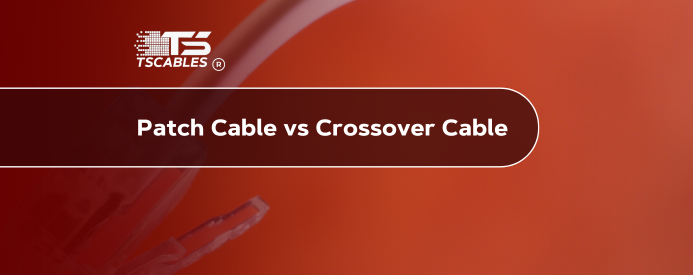Wires might all look alike at first glance, but what they do can be completely different. In network setups, whether it’s a home office, a classroom, or a large business, knowing which type of cable to use keeps everything running smoothly.
Patch cables and crossover cables often get mixed up. They both move data, connect devices, and fit into the same ports. But they are not interchangeable. Using the wrong one can leave a system stuck, slow, or unresponsive.
This isn’t just about what works, it’s about what works right. The wrong cable can stop devices from talking to each other. For someone building a reliable setup, that becomes a real pain. No one wants to crawl under a desk just to switch out a cable after the fact.
So, what are patch cables? What are crossover cables? And what are they used for? This guide breaks things down in plain terms.
Whether you’re wiring a home office or dealing with gear at work, you’ll find out what connects where and why. You’ll also see how each type fits into the bigger picture of smooth data sharing and device communication.
What are Patch Cables?
Patch cables, also known as straight-through cables, are used to connect different types of devices within a network. They have identical wiring on both ends, ensuring consistent signal transmission.
These cables are typically used to connect computers to switches, routers to modems, or other dissimilar devices. The wiring standards for patch cables follow either the T568A or T568B configurations, with both ends adhering to the same standard.
This uniformity ensures that the transmit and receive signals align correctly between devices. Patch cables are available in various categories, including Cat5e, Cat6, and Cat6a, each supporting different data transfer speeds and bandwidths.
What are patch cables used for? They are primarily utilized in structured cabling systems, connecting end-user devices to the network infrastructure. Their versatility and ease of use make them a staple in both home and enterprise networking environments.
What are Crossover Cables?
Crossover cables are designed to connect similar devices directly without the need for an intermediary device like a switch or hub.
Unlike patch cables, crossover cables have different wiring standards on each end, one end follows the T568A standard, while the other adheres to T568B. This configuration allows the transmit and receive signals to be appropriately aligned between similar devices.
Crossover cables are commonly used to connect two computers directly, link two switches, or connect two hubs. They are particularly useful in scenarios where a direct device-to-device connection is required without additional networking equipment.
The crossover cable wiring ensures that the transmit pins on one end are connected to the receive pins on the other, facilitating proper communication between devices.
With the advent of Auto MDI-X technology in modern networking equipment, the necessity for crossover cables has diminished, but they remain relevant in specific situations.
Which One To Choose for Your Needs?
Selecting between a patch cable and a crossover cable depends on the devices you intend to connect. Understanding the specific use cases for each cable type will guide you in making the appropriate choice. Below are detailed scenarios to help determine the best cable for your networking requirements.
Connecting Dissimilar Devices
When connecting devices of different types, such as a computer to a switch or a router to a modem, a patch cable is the appropriate choice. The uniform wiring ensures seamless communication between the devices.
Direct Device-to-Device Connections
For direct connections between similar devices, like two computers or two switches, a crossover cable is necessary. The crossed wiring aligns the transmit and receive signals, enabling proper communication without intermediary devices.
Modern Networking Equipment
Many modern networking devices support Auto MDI-X, which automatically detects the required cable type and adjusts accordingly. In such cases, a standard patch cable can be used even for direct connections between similar devices.
Cable Categories and Performance
Both patch and crossover cables come in various categories, such as Cat5e, Cat6, and Cat6a. The choice of category depends on the required data transfer speeds and bandwidth. For instance, a Cat6e crossover cable supports higher speeds and reduced crosstalk compared to its predecessors.
Identifying Cable Types
To distinguish between patch and crossover cables, examine the wiring standards at each end. Patch cables have identical wiring on both ends, while crossover cables have different standards (T568A on one end and T568B on the other). Additionally, some cables are color-coded or labeled for easy identification.
Conclusion
Understanding the differences between patch and crossover cables is crucial for setting up effective network connections. By selecting the appropriate cable type based on your specific needs, you can ensure reliable and efficient communication between devices.
TS Cables offers a wide range of high-quality networking cables to meet your requirements. Explore our selection to find the perfect solution for your networking needs.
FAQs
Q: What is a patch cable used for?
A patch cable connects different types of devices within a network, such as a computer to a switch or a router to a modem.
Q: When to use a crossover cable?
Use a crossover cable when connecting similar devices directly, like two computers or two switches, without an intermediary device.
Q: What is the difference between a patch cable and an Ethernet cable?
A patch cable is a type of Ethernet cable used for short-distance connections, typically within a rack or between devices.
Q: Do modern devices still require crossover cables?
Many modern devices support Auto MDI-X, reducing the need for crossover cables. However, they may still be necessary for certain older equipment.
Q: Can I use a patch cable instead of a crossover cable?
If both devices support Auto MDI-X, a patch cable can be used in place of a crossover cable. Otherwise, a crossover cable is required for direct connections between similar devices.






